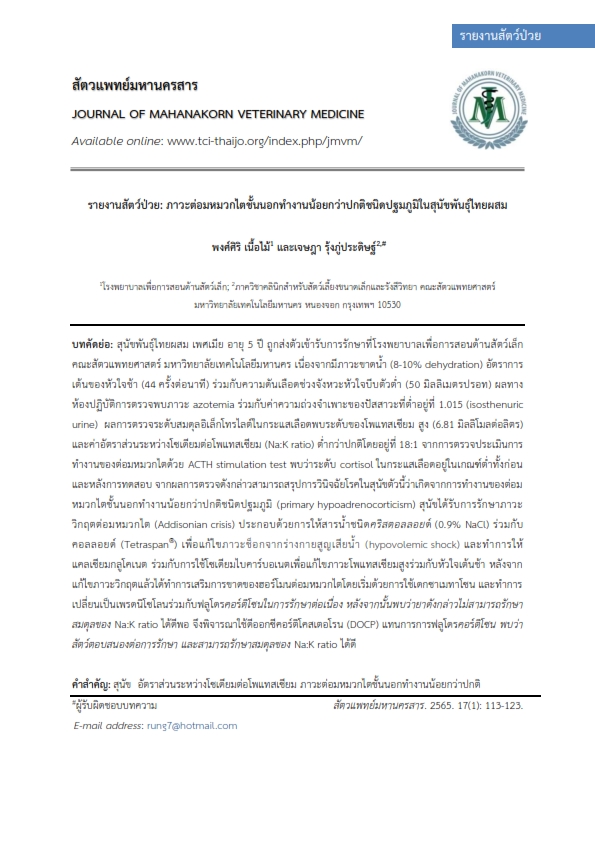Primary Hypoadrenocorticism in a Thai Mixed Dog: Case Report
Main Article Content
Abstract
A 5-year-old female mixed Thai dog was referred to The Small Animal Teaching Hospital, Faculty of Veterinary Medicine, Mahanakorn University of Technology with presenting signs of 8-10% dehydration, bradycardia (44 bpm) and systemic hypotension (systolic blood pressure 50 mmHg). Laboratory results showed azotemia and isosthenuric urine (1.015). Blood electrolytes found hyperkalemia (6.81 mmol/l), hyponatremia (124 mmol/l) and low Na:K ratio (18:1). An adrenocorticotropic hormone (ACTH) stimulation test was performed, and the low level of cortisol was observed in both pre and post period of tests. From Laboratory results and ACTH stimulation test, primary hypoadrenocorticism was diagnosed. The Addison crisis was corrected by using isotonic crystalloid (0.9% NaCl) in combination with colloid (Tetraspan®) for treatment of hypovolemic shock. Calcium gluconate and sodium bicarbonate were used to correct hyperkalemia and bradycardia. After stabilizing the dog, hormone supplements were started by using dexamethasone. The combination of prednisolone with fludrocortisone were dispensed for continuing hormone supplements at home. After the 2-month period of treatment, fludrocortisone was substituted to desoxycorticosterone pivalate (DOCP) due to the dog’s inability to maintain the balance of Na:K ratio. With this treatment the dog responded well and was able to maintain the balance of Na:K ratio.
Article Details

This work is licensed under a Creative Commons Attribution-NonCommercial-NoDerivatives 4.0 International License.
References
Adler, J.A., Drobatz, K.J., and Hess, R.S. 2007. Abnormalities of Serum Electrolyte Concentrations in Dogs with Hypoadrenocorticism. J. Vet. Intern. Med. 21(6): 1168–1173.
Bates, J.A., Shott, S., and Schall, W.D. 2013. Lower initial dose deoxycorticosterone pivalate for treatment of canine primary hypoadrenocorticism. Aus. Vet. J. 91(3): 77-82.
Brady, C.A., Vite, C.H., and Drobatz, K.J. 1999. Severe neurologic sequelae in a dog after treatment of hypoadrenal crisis. J. Am. Vet. Med. Assoc. 215(2): 222–225, 210.
Church, D.B. 2004. Canine hypoadrenocorticism In: Mooney, C.M. and Peterson, M.E. BSAVA manual of canine and feline endocrinology. 3rd ed. British Small Animal Veterinary Association. Quedgeley, Gloucester: 172.
Kintzer, P., and Peterson, M. 1997. Treatment and long-term follow-up of 205 dogs with hypoadrenocorticism. J. Vet. Intern. Med. 11(2): 43-49.
Klein, S.C., and Peterson, M.E. 2010. Canine hypoadrenocorticism: Part I. Can. Vet. J. 51: 63-69.
Lathan, P., and Thompson, A. 2018. Management of hypoadrenocorticism (Addison’s disease) in dogs. Vet. Med. (Auckl). 9: 1-10.
Lathan, P., and Tyler, J. 2005. Canine hypoadrenocorticism: pathogenesis and clinical features. Comp. Cont. Educ. Pract. 27(2): 110-120.
Lathan, P., Scott-Moncrieff, J.C., and Wills, R. W. 2014. Use of the Cortisol-to-ACTH Ratio for Diagnosis of Primary Hypoadrenocorticism in Dogs. J. Vet. Intern. Med. 28(5): 1546-1550.
Lennon, E.M., Boyle, T.E., and Hutchnins, R.G. 2007. Use of basal serum or plasma cortisol concentrations to rule out a diagnosis of hypoadrenocorticism in Dogs: 123 cases (2000-2005). JAVMA. 231(3): 413-416.
McCabe, M.D., Feldman, E.C., Lynn, R.C., and Kass, P.H. 1995. Subcutaneous administration of deoxycorticosterone pivalate for treatment of canine hypoadrenocorticism. JAAHA. 31(2): 151-155.
Melián, C., and Peterson, M.E. 1996. Diagnosis and treatment of naturally occurring hypoadrenocorticism in 42 dogs. J. Small Anim. Pract. 37(6): 268-275.
Nielsen, L., Bell, R., Zoia, A., Mellor, D.J., Neiger, R., and Ramsey, I. 2008. Low ratios of sodium to potassium in the serum of 238 dogs. VET. REC. 162(14): 431-435.
Oberbauer, A.M., Bell, J.S., Belanger, J.M., and Famula, T.R. 2006. Genetic evaluation of Addison’s disease in the Portuguese Water dog. BMC Vet. Res. 2: 15.
Peterson, M.E., Kintzer, P.P., and Kass, P.H. 1996. Pretreatment clinical and laboratory findings in dogs with hypoadrenocorticism: 225 cases (1979-1993). J. Am. Vet. Med. Assoc. 208(1): 85-91.
Platt, S.R., Chrisman, C.L., Graham, J. and Clemmons, R.M. 1999. Secondary hypoadrenocorticism associated with craniocerebral trauma in dog. JAAHA. 35(2): 117-122.
Plumb, D.C. 2015. Plumb's veterinary drug handbook. 8th ed. PharmaVet. Stockholm, Wisconsin: 1296 p.
Roth, L., and Tyler, R.D. 1999. Evaluation of Low Sodium: Potassium Ratios in Dogs. J. VET. DIAGN. INVEST. 11(1): 60-64.
Scott-Moncrieff, J.C. 2015. Chapter 12: Hypoadrenocorticism. In: Feldman, E.C., Nelson, R.W., and Reusch, C.E. Canine and Feline Endocrinology. 4thed. Elsevier. St. Louis, Missouri: 485-520.
Seitz, M. 2018. (cited 1 March 2020). Managing Canine Addisonian Crisis. Available from: https://www.cliniciansbrief.com/article/managing-canine-addisonian-crisis. 25-30.
Seth, M., Drobatz, K.J., Church, D.B., and Hess, R.S. 2011. White blood cells count and the sodium to potassium ratio to screen for hypoadrenocorticism in dogs. J. Vet. Intern. Med. 25(6): 1351-1356.
Van Lanen, K., and Sande, A. 2014. Canine Hypoadrenocorticism: Pathogenesis, Diagnosis, and Treatment. Top. Comp. Anim. Med. 29(4): 88-95.


